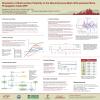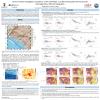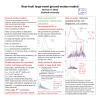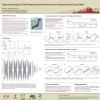Poster #219, Ground Motions
A Nonergodic Ground Motion Model in Southern California with Spatially Varying Coefficients Using a SCEC CyberShake Dataset
Poster Image:

Poster Presentation
2020 SCEC Annual Meeting, Poster #219, SCEC Contribution #10505 VIEW PDF
A key input to probabilistic seismic hazard analyses (PSHA) is the total standard deviation of the misfits between ground motion observations and the median ground motion models (GMMs, a.k.a GMPEs). The most promising way to reduce hazard is to reduce total standard deviation through the removal of the ergodic assumption. Although strong motion networks have been rapidly growing in recent decades, in most cases the empirical data are still too sparse to establish a fully nonergodic model. In comparison, numerical simulations can generate large ground motion datasets for controlled earthquake sources and sites, which are optimal to investigate the reduction of total standard deviation by identifying and removing repeatable effects in a fully nonergodic model. However, before such PSHA products based on simulations are accepted for engineering applications, it is crucial to validate the simulated ground motions against empirical data and models.
In this study, we evaluate the ability of the physics-based CyberShake platform to capture the repeatable site and path effects from the empirical data, by applying the spatially varying coefficient model (SVCM) as part of the regression analyses. We use CyberShake Study 15.4 at 5s period, which was computed for southern California and generated over 97 million ground motion seismograms at 336 sites. We first conduct a checkerboard test and make sure that SVCM is capable of capturing the input source, site and path terms without significant leakage between the partitioned residuals. Then, we compute the total residuals from CyberShake datasets using linear regression with a simple GMM functional form. Finally, we assign spatially varying source effects, site effects and cell-specific anelastic attenuation by applying the SVCM technique. Preliminary results show systematically large site effects within Los Angeles and Ventura basins, which are expected from basin effects. There are also stronger anelastic attenuation within the Los Angeles Basin compared to surrounding areas. The results are contrasted with those from sparser empirical datasets, using a similar regression technique, and discussion of discrepancy is presented.
In this study, we evaluate the ability of the physics-based CyberShake platform to capture the repeatable site and path effects from the empirical data, by applying the spatially varying coefficient model (SVCM) as part of the regression analyses. We use CyberShake Study 15.4 at 5s period, which was computed for southern California and generated over 97 million ground motion seismograms at 336 sites. We first conduct a checkerboard test and make sure that SVCM is capable of capturing the input source, site and path terms without significant leakage between the partitioned residuals. Then, we compute the total residuals from CyberShake datasets using linear regression with a simple GMM functional form. Finally, we assign spatially varying source effects, site effects and cell-specific anelastic attenuation by applying the SVCM technique. Preliminary results show systematically large site effects within Los Angeles and Ventura basins, which are expected from basin effects. There are also stronger anelastic attenuation within the Los Angeles Basin compared to surrounding areas. The results are contrasted with those from sparser empirical datasets, using a similar regression technique, and discussion of discrepancy is presented.






























































